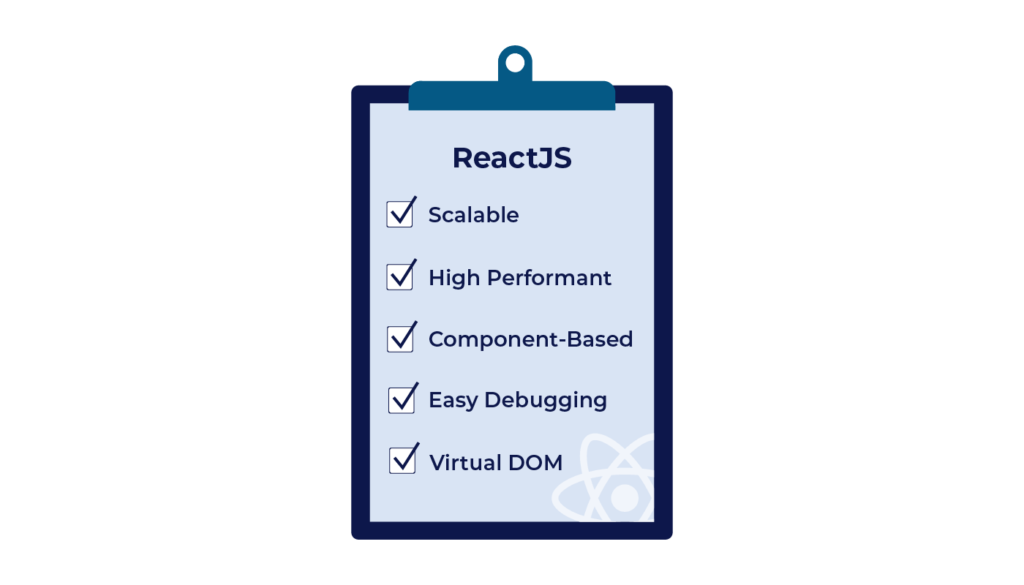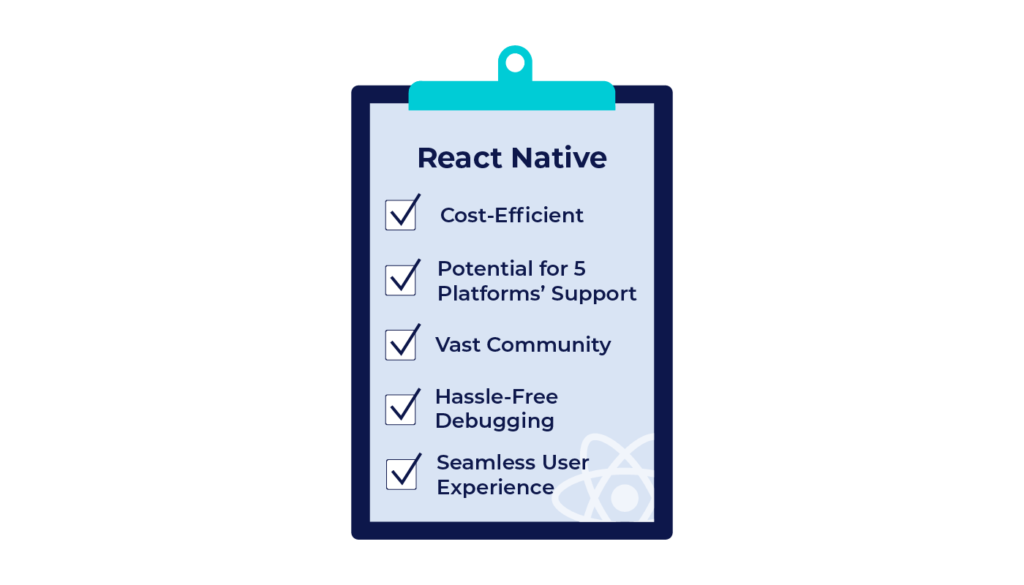Having trouble deciding between React and React Native? Unsure which technology to choose? We’ll help you understand the differences between React and React Native. We’ll outline the advantages and disadvantages of both techs. By the end, when it’s better to opt for React.js vs React Native.
We often get confused when we have to choose between options that sound as similar as React vs. React Native. Whether it’s technologies, products, or frameworks, we turn to Google to sort through the information overload. Why all this talk, about confusion? Well, in the tech world terms, like React and React Native can easily get muddled up even causing experienced developers to feel puzzled.
Both React and React Native stand out as robust technologies to develop scalable web and mobile solutions. And both were developed by Facebook and use one of the most widely used programming languages— JavaScript. While their names may appear interchangeable at a glance, there’s more than meets the eye. If you’re still struggling to understand their differences don’t worry! You’ve found yourself reading the guide, to unraveling their distinctions.
So what’s the deal with React vs. React Native? Why the confusion? Let’s delve into this topic in detail.
React vs. React Native: Overview
React is an open-source JavaScript library for building user interfaces. It was created by Jordan Walke, a software engineer at Facebook. There was a goal of quickly building scalable interfaces, and React.js came into existence to simplify JavaScript development. Following the success of React.js, Facebook sought to deliver all of its benefits to mobile and developed React Native – a framework for creating cross-platform mobile apps on iOS, Android, Windows and other platforms.
React and React Native are behind some of the most popular web and mobile applications. They represent different aspects of the React ecosystem and serve different purposes. So, let’s take a dive deep to understand when it’s better to opt for React.js vs React Native.
| Key takeaway: React is primarily a library for web UIs, whereas React Native serves as a framework for developing cross-platform mobile applications. |
Introduction to React.js and Its Features
What is React.js?
React (aka React.js or ReactJS) is a JavaScript library for building responsive user interfaces. It was open-sourced at JSConf US in May 2013. According to Google Trends, React has been gathering steam since 2017, and it shows no signs of stopping. React is widely used in web development to build comprehensive apps and software.
The library is based on JavaScript, which means developers can get access to a vivid society of contributors who have created a massive ecosystem of tools to make an engineer’s life easier, including React Developer Tools (inspection of the hierarchies of components in the vDOM), React Sight (visualization of component hierarchy tree). You can stay updated on the trends through React’s official channels.
Notable Features of React.js
React is a popular choice for web projects due to its mild learning curve, relatively fast development, and notable performance. This allows for web application development of various scope and complexity. Notably, about 15% of the top 1 million websites with the highest traffic, use React.
- Optimized Performance
Virtual DOM is one of the defining features of React. It guarantees a minimum update time to the real DOM, provides higher performance and a better user experience.
- Convenient Debugging
The component-based architecture in React eliminates the need for frequent debugging. If you edit one part of the app, it doesn’t affect other parts.
- Huge Community
Being one of the first JavaScript libraries, React.js has gathered quite a crowd of followers. It enjoys the support of both Facebook and is blessed to have a huge community of software developers that provides valuable solutions that facilitate the development of the technology.

Types of Projects React.js is Best Suited For
What are React’s most widespread usages? Its purpose is to allow building high-performing interfaces. React plays an important role in:
First used for the newsfeed, React is used extensively for the web version of Facebook.com.
React was implemented to roll out the web version of Instagram. API requests with Google Maps, geolocation services, search functionality, and tagging are supported through the framework.
Asana
Asana, a leading project management tool, employed React to address client-side performance problems. The front-end was rewritten in React.
Netflix
As written on the Netflix blog, React enabled them to build a tremendous foundation. React was adopted because of its startup speed, runtime performance, and modularity.
Further afield, Airbnb, WhatsApp, Dropbox, Yahoo Mail, Medium, Udemy, Codecademy, and New York Times all use React.
How does React.js Differ from Its Rivals?
Today, Facebook’s technology enjoys huge rates of growing popularity. React is the most widely used JS library – it has become a go-to choice for most front-end developers. You can also overview best front-end frameworks in our article.
- The groundbreaking feature of React is Virtual DOM. It doesn’t require a response from a browser, which is why the code is rendered faster. Virtual DOM provides improved performance, and a better user experience compared to manually handling DOM changes.
- Another prominent feature is the ability to reuse components – developers don’t need to write different codes for similar app components. React introduced the concept of component-based architecture, which enforces the reusability of components as per your requirement. It can save an enormous amount of time.
- Since React is capable of server-side rendering, it gives a power boost to SEO (with the use of extra tools like Next.js, for example).
- Community-powered innovation makes React one of the most popular options for creating innovative apps.
Introduction to React Native and Its Features
What is React Native?
React Native enables building native-like mobile apps for Android, iOS, and Universal Windows Platform (UWP) and other platforms. In 2012 Mark Zuckerberg commented, “The biggest mistake we made as a company was betting too much on HTML as opposed to native.” He promised that Facebook would deliver a better mobile experience. React Native was developed after React to meet the growing need for high-quality cross-platform development. It was open-sourced in March 2015.
Before React Native was invented, developers had to use various tools for different web and mobile platforms. Rich React Native components allow mobile app developers to save a lot of time, especially with its new architecture. Your team won’t dissipate efforts on creating one app for iOS, one for Android, one for Windows, etc. Most of the JS code could be reused and enhanced with native modules or code.
According to the Stack Overflow survey 2020, React Native is one of the most popular technologies – 58%.
Notable Features of React Native
React Native inherited most of the benefits from its elder brother. But in contrast to React, React Native components are used for developing mobile apps that can be run on several platforms. In addition to that, it has platform-specific APIs, design patterns, and other differences. React Native has proven its capability to offer an environment where you can successfully create your mobile apps.
Code Reusability
The shining achievement of React Native is that developers don’t need to write separate platform-specific codes for iOS and Android platforms. Also, they can partially share the code for the web, which allows for better teamwork.
Reduced Costs
As there is only one code base for all platforms, React Native can be used to build applications that are compatible with Android and iOS. This means that the team will save on development, maintenance, and administrative costs. The other cost-saving comes from the fact that React Native is completely license-free.
Responsive UI
React Native components are capable of providing users with native-like experience as they utilize native user interfaces in developing responsible mobile apps. If you are on a budget but need a cost-effective and quality solution that would run on several platforms, React Native is your choice.
Hot & Live Reloading
If the business logic needs to be modified, you can tweak the user interface without any loss of your app’s platform-specific code.
Declarative UI
The idea behind this feature is pretty simple — it renders content by returning some JSX. Mobile user interface is based on a declarative programming paradigm – engineers can focus on what needs to be implemented rather than how to do this.
Rich Community
React Native was conceived through a Facebook-run hackathon, and since then, it has been extensively supported by its community. If you face any issue during the development process, it will be easily solved. A large global developer community continuously contributes with their knowledge, solutions, tools, etc.

How Does React Native Differ From Its Rivals?
If you need to build an app that you can easily launch on several platforms, there is nothing better than React Native. Today, it is an undisputed leader in the niche. These pros give React Native the edge over other cross-platform frameworks:
- One of the major advantages of React Native is that it lets you develop native-like apps but doesn’t compromise on user experience or code quality.
- React Native lets you significantly cut your product’s time to market. Instead of building two separate apps, you can build one code base and launch it, which reduces the development time.
- It uses JavaScript, which makes the transition from web to mobile development easier. What does it mean for you? Finding React Native developers is often easier, which also contributes to faster mobile development.
- Unlike Cordova, PhoneGap, and other cross-platform frameworks that render code via WebView, React Native renders certain platform-specific code components with native API’s.
- The component-based structure allows developers to build apps with a more agile approach than most hybrid frameworks.
- React Native provides a module that detects the platform in which the app is running and loads the right code for the right platform.
Types of Projects React Native is Best Suited For
React Native is powering some of the most popular mobile apps, including:
Facebook’s Mobile Applications
The main app and Facebook Ads are built on React Native for Android.
Instagram App
After Facebook acquired Instagram, React Native was integrated into Instagram’s native app.
Skype
In 2017, Skype announced that the app will be completely rewritten in React Native. It was used not only for the mobile platforms but also on the Windows desktop app.
Tesla
Tesla uses React Native for apps that support their Powerwall battery and smart car products.
WIX
The mobile application of WIX, a famous website builder, is entirely written in React Native. Tal Kol, former head of mobile engineering at Wix, said that React Native was a game-changing technology for Wix.
React and React Native Features
The difference between React vs. React Native is significant. React is designed for web development whereas React Native is used for cross-platform mobile development. Let’s sum up the difference between React and React Native in a brief checklist. Below is an overview of both – it should give you a fair idea of what makes them different to make an informed decision based on your priorities and expected outcome.
| Name | React | React Native |
| Type | JavaScript library used for making User Interface. | Framework used for mobile app development. |
| Developed By | ||
| Release | 2013 | 2015 |
| Open-source | Yes | Yes |
| Usage | React is used for developing web-based applications. | React Native is used in mobile app development. |
| UI Rendering | The Virtual DOM renders the browser code. | Uses platform-specific APIs to render code for mobile applications. |
| Platform Dependency | React has no dependency on a particular platform. | React Native is platform-dependent (to a degree). |
| Navigation | React Navigation | React Native Navigation |
| Animation | CSS Animation | React Native offers its custom tools (Animated API, Reanimated). |
| Security | Security issues shared by all other JS frameworks | Along with the built-in libraries used for the UI specifically, it offers comparatively low-security features. |
| Cost | Cost-effective | Cost-effective |
When to Choose React and When React Native
When deciding between React vs. React Native for the development of web or mobile applications, several factors play a role. Both frameworks are developed by Facebook and offer different advantages depending on the type of project and requirements. Here’s a breakdown of when to choose React and when to choose React Native.
When to Choose React:
- Web Applications: React is primarily designed for building user interfaces for web applications. If your project focuses solely on web development, React is the natural choice.
- Complex Web Interfaces: For applications with intricate user interfaces that demand dynamic updates and interactive components, React’s virtual DOM and component-based architecture provide a powerful solution.
When to Choose React Native:
- Cross-Platform Mobile Applications: If your project requires a single codebase to target both iOS and Android platforms, React Native offers significant advantages. It allows developers to write code once and deploy it across multiple mobile platforms, saving time and effort.
- Native Mobile Features Integration: When your application requires access to native device features such as camera, GPS, accelerometer, and others, React Native provides seamless integration. Developers can leverage native modules or third-party libraries to access these features.
Choose React for web applications, especially with complex user interfaces and SEO requirements. However, opt for React Native to create cross-platform mobile applications. React Native ensures smooth integration of native functions, improved performance, and cost efficiency. Carefully, evaluate the project requirements and consider these factors to make an informed decision between React and React Native.
Conclusion
React.js is an optimal solution for creating high-performing web apps with complex functionality and complex calculations, and React Native is ideal for giving a native touch to your cross-platform mobile apps. Instead of making a leap of faith, rely on our professional team to create a software solution tailored to your business needs and goals. We provide top-notch React and React Native development services that will make your project stand out.





